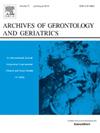儿童期和成年期社会经济地位与脆弱指数轨迹的关系:基于中国健康与退休纵向研究(CHARLS)的五波面板数据
IF 3.5
3区 医学
Q2 GERIATRICS & GERONTOLOGY
引用次数: 0
摘要
童年和成年社会经济地位(SES)与长期脆弱轨迹之间的关系尚不清楚。我们旨在评估脆弱指数(FI)动态轨迹,并检查儿童期和成年期SES与脆弱轨迹之间的关联。方法我们从2011-2020年中国健康与退休纵向研究(CHARLS)中纳入7321名年龄在45岁及以上的参与者。包括6个儿童期SES因素和4个成年期SES因素。基于群体的轨迹模型用于识别脆弱轨迹,多项逻辑回归用于评估SES与脆弱轨迹之间的关联。结果分为3组:低升高组(LT, 59.9%)、中升高组(MT, 31.7%)和高升高组(HT, 8.4%)。以LT组为参照,母亲不识字(相对风险比[RRR]=1.67, 95%可信区间[CI]: 1.10-2.52)、食物不足(1.67,1.34-2.09)、家庭经济状况(2.35,1.61-3.42)和儿童健康状况(2.72,2.09-3.53)较差的儿童出现儿童期SES的几率高于其他组。在成年SES中,农村户籍(1.86,1.50 ~ 2.31)、中学以下文化程度(2.75,1.83 ~ 4.15)的人出现HT组的几率更高。在不同年龄、性别和居住地的人身上也发现了类似的结果。结论社会经济地位较低(包括母亲和自身受教育程度低、童年饥饿、家庭经济状况和童年健康状况较差)的参与者更容易经历FI高增长轨迹,即衰老更快。应注意减少生命早期的社会不平等,从而促进晚年健康老龄化。本文章由计算机程序翻译,如有差异,请以英文原文为准。
Association of childhood and adulthood socioeconomic status with frailty index trajectories: Using five-wave panel data from the China Health and Retirement Longitudinal Study (CHARLS)
Background
The relationship between childhood and adulthood socioeconomic status (SES) and long-term frailty trajectories is unclear. We aimed to assess the frailty index (FI) dynamic trajectories and examine the associations between childhood and adulthood SES and frailty trajectories.
Methods
We included 7321 participants aged 45 and older from the 2011–2020 China Health and Retirement Longitudinal Study (CHARLS). Six childhood SES factors and four adulthood SES factors were included. Group-based trajectory modelling was used to identify frailty trajectories and multinomial logistic regression was used to assess the association between SES and frailty trajectories.
Results
Three frailty trajectory groups were identified: low-increase trajectory (LT, 59.9 %), moderate-increase trajectory (MT, 31.7 %) and high-increase trajectory (HT, 8.4 %). With the LT group as reference, for childhood SES, participants with an illiterate mother (relative-risk radio [RRR]=1.67, 95 % confidence interval [CI]: 1.10–2.52), having not enough food (1.67, 1.34–2.09), with family's financial situation (2.35, 1.61–3.42) and childhood health status (2.72, 2.09–3.53) worse than others had higher odds of being in the HT group. For adulthood SES, rural residence (1.86, 1.50–2.31), with an educational level of less than middle school (2.75, 1.83–4.15), had higher odds of being in the HT group. Similar results were found for people of different ages, genders, and residences.
Conclusions
Participants with lower SES, including maternal and self- low education, childhood hunger, worse family financial and childhood health status are more likely to experience a high-increase FI trajectory, i.e. aging faster. Attention should be paid to reduce early-life social inequalities thus to promote later-time healthy aging.
求助全文
通过发布文献求助,成功后即可免费获取论文全文。
去求助
来源期刊
CiteScore
7.30
自引率
5.00%
发文量
198
审稿时长
16 days
期刊介绍:
Archives of Gerontology and Geriatrics provides a medium for the publication of papers from the fields of experimental gerontology and clinical and social geriatrics. The principal aim of the journal is to facilitate the exchange of information between specialists in these three fields of gerontological research. Experimental papers dealing with the basic mechanisms of aging at molecular, cellular, tissue or organ levels will be published.
Clinical papers will be accepted if they provide sufficiently new information or are of fundamental importance for the knowledge of human aging. Purely descriptive clinical papers will be accepted only if the results permit further interpretation. Papers dealing with anti-aging pharmacological preparations in humans are welcome. Papers on the social aspects of geriatrics will be accepted if they are of general interest regarding the epidemiology of aging and the efficiency and working methods of the social organizations for the health care of the elderly.

 求助内容:
求助内容: 应助结果提醒方式:
应助结果提醒方式:


